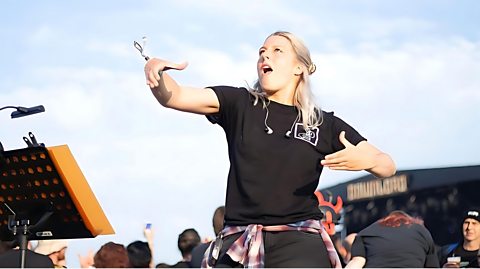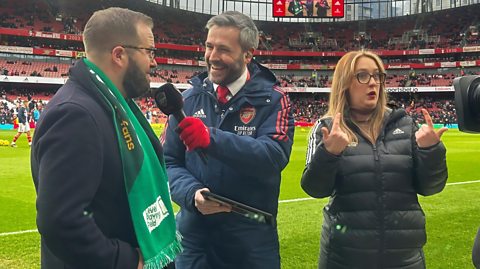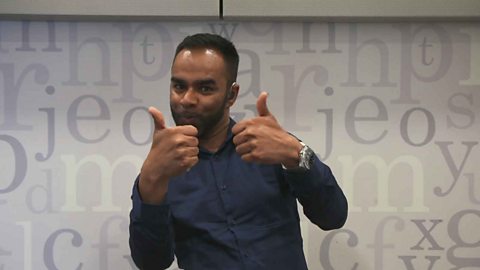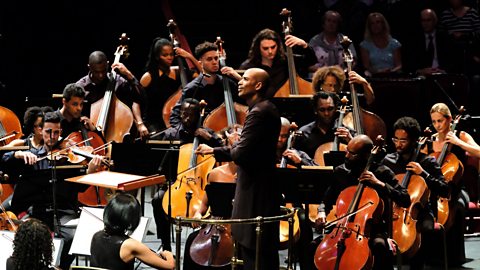Just because you can’t hear music, it doesn’t mean you can’t connect with it.
Profoundly deaf in one ear, Marie Pascall struggled to pick up the lyrics at concerts without the help of a performance interpreter - so she became one herself.
She now runs Performance Interpreting, a British Sign Language service for major events - including the 91»»±¨ Proms - where her team will be interpreting Beethoven‚Äôs 'Choral' symphony in the concert Ninth by Heart in August 2024.
A performance in itself
The goal of an interpreter is to express the whole experience of witnessing a performance, not just what instrument is playing or the words of a song. Every element needs to be communicated - the rhythm, the tone, the emotional meaning of the lyrics as well as what those lyrics are, the personality of the performer, and anything they might say.
 Image source, Performance Interpreting
Image source, Performance InterpretingMarie has a performing arts background and told 91»»±¨ Bitesize about the reasoning behind this approach: ‚ÄúPeople get fixated that music is about sound, but every piece of music that's composed has to come from a personal feeling.
“The composer will project that feeling into the music, and that's transcended out to the audience. So it's actually a feeling that we're trying to reflect, because that's what the audience will hold on to as a memory.”
Why no two interpreters are the same
As well as signing any lyrics, interpreters use their whole body to represent the music. As people’s responses to music are extremely personal, no two interpreters would express it in exactly the same way.
 Image source, Performance Interpreting
Image source, Performance InterpretingMarie said: “It's rare that we would do a whole classical piece for two or three hours. We want to make sure what we're delivering is meaningful, so we might show that the trumpets are playing but we wouldn’t stay on there for three minutes pretending to play the trumpet.”
They use body language to show the shape of the notes, their length and speed, and how the music makes them feel. Marie said: “If it's operatic, the end note might be sung for 10 seconds. We would continue to elongate the note using our hands and our facial expressions.”
When there are no lyrics to translate
When there are no lyrics to sign, it’s a balancing act between the interpreters expressing what it is like to experience the music and allowing the audience to enjoy elements of the performance they can sense for themselves. It is usual for interpreters to introduce the music with some detail of who the performers are and what instruments are being played.
Marie said: “Then they may introduce the tone, the tempo through their hands. And if the music changes, we would show them - the pace has changed, now it’s the trumpets, now it’s the drums. If it's gentle or if it's really loud and prominent, we would show that through our body language.”
 Image source, Performance Interpreting
Image source, Performance InterpretingEvery interpreter has their own way of moving their body - and some are more suitable for certain types of music than others. Marie added: “For classical music, we tend to allocate the work to people that have a very elegant style, so they may be more gentle with their hands and their delivery. I describe it as like a ballet dancer compared to a hip hop dancer.”
It can take anything from 20 to more than 100 hours of work to prepare for a performance. Interpreters research the band, orchestra or singers as well as the music to ensure they are familiar with the lyrics and the meaning of the tunes. Not all performers provide a setlist so interpreters look on websites which show lists from previous performances to get an idea of potential pieces.
Choral music, such as Prom 42: Beethoven’s Ninth by Heart, is often sung in a language other than English (in this case, German), so interpreters will spend time studying an English translation.
What sets a good interpreter apart
It’s a job that can be physically demanding, Marie warned. Interpreters tend to work in pairs to prevent fatigue because: “if you become burned out, the quality of your work is affected”.
Lots of energy is required keep up the enthusiasm levels, as well as strong interpreting skills that convey emotion. Flexibility is also key as there can be last-minute changes to the setlists and running orders.
 Image source, Performance Interpreting
Image source, Performance InterpretingMarie explained that it can take between seven and 10 years to become a sign language interpreter and, after that, she recommended working for three years to hone those skills, before learning to be a performer interpreter on an official course.
As well as making performances accessible to deaf audiences, Marie is also keen that a career in interpreting is open to deaf people - and with the right tools to fit their individual needs that’s entirely possible. Interpreters who wear hearing aids may have equipment that amplifies the sound. Other people work off captions or have a second interpreter opposite them giving them the lyrics, which they will then interpret themselves.
Marie said: “It’s great to see a deaf performer or interpreter because they’re a role model for other deaf customers. Their expressiveness of the language can be phenomenal.”
This article was published in August 2024
How sign language changed my life
Esmail tells us how learning to sign opened a new world for him.

Classical music is everywhere in pop culture if you look hard enough.

The remarkable first 150 years of the Royal Albert Hall
A venue that's welcomed pop stars, classical musicians and the world's first sci-fi convention
